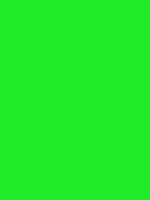#1feb28 Color Information
In a RGB color space, hex #1feb28 is composed of 12.2% red, 92.2% green and 15.7% blue. Whereas in a CMYK color space, it is composed of 86.8% cyan, 0% magenta, 83% yellow and 7.8% black. It has a hue angle of 122.6 degrees, a saturation of 83.6% and a lightness of 52.2%. #1feb28 color hex could be obtained by blending #3eff50 with #00d700. Closest websafe color is: #33ff33.
-
- R 12
- G 92
- B 16
-
- C 87
- M 0
- Y 83
- K 8
● #1feb28 color description : Vivid lime green.
#1feb28 Color Conversion
The hexadecimal color #1feb28 has RGB values of R:31, G:235, B:40 and CMYK values of C:0.87, M:0, Y:0.83, K:0.08. Its decimal value is 2091816.
| Hex triplet | 1feb28 | #1feb28 |
|---|---|---|
| RGB Decimal | 31, 235, 40 | rgb(31,235,40) |
| RGB Percent | 12.2, 92.2, 15.7 | rgb(12.2%,92.2%,15.7%) |
| CMYK | 87, 0, 83, 8 | |
| HSL | 122.6°, 83.6, 52.2 | hsl(122.6,83.6%,52.2%) |
| HSV (or HSB) | 122.6°, 86.8, 92.2 | |
| Web Safe | 33ff33 | #33ff33 |
| CIE-LAB | 81.761, -78.492, 72.809 |
|---|---|
| XYZ | 30.655, 59.858, 11.945 |
| xyY | 0.299, 0.584, 59.858 |
| CIE-LCH | 81.761, 107.062, 137.151 |
| CIE-LUV | 81.761, -75.135, 95.973 |
| Hunter-Lab | 77.368, -64.668, 45.003 |
| Binary | 00011111, 11101011, 00101000 |
Color Schemes with #1feb28
Alternatives to #1feb28
Below, you can see some colors close to #1feb28. Having a set of related colors can be useful if you need an inspirational alternative to your original color choice.
#1feb28 Preview
This text has a font color of #1feb28.
<span style="color:#1feb28;">Text here</span>This paragraph has a background color of #1feb28.
<p style="background-color:#1feb28;">Content here</p>This element has a border color of #1feb28.
<div style="border:1px solid #1feb28;">Content here</div>.text {color:#1feb28;}.background {background-color:#1feb28;}.border {border:1px solid #1feb28;}Shades and Tints of #1feb28
A shade is achieved by adding black to any pure hue, while a tint is created by mixing white to any pure color. In this example, #010a01 is the darkest color, while #f7fef7 is the lightest one.
-
#010a01
#010a01rgb(1,10,1) -
#031c04
#031c04rgb(3,28,4) -
#042e06
#042e06rgb(4,46,6) -
#064008
#064008rgb(6,64,8) -
#07520b
#07520brgb(7,82,11) -
#09640d
#09640drgb(9,100,13) -
#0b760f
#0b760frgb(11,118,15) -
#0c8812
#0c8812rgb(12,136,18) -
#0e9a14
#0e9a14rgb(14,154,20) -
#0fac16
#0fac16rgb(15,172,22) -
#11be19
#11be19rgb(17,190,25) -
#13d01b
#13d01brgb(19,208,27) -
#14e21d
#14e21drgb(20,226,29)
-
#1feb28
#1feb28rgb(31,235,40) -
#31ed39
#31ed39rgb(49,237,57) -
#43ee4b
#43ee4brgb(67,238,75) -
#55f05c
#55f05crgb(85,240,92) -
#67f16d
#67f16drgb(103,241,109) -
#79f37e
#79f37ergb(121,243,126) -
#8bf590
#8bf590rgb(139,245,144) -
#9df6a1
#9df6a1rgb(157,246,161) -
#aff8b2
#aff8b2rgb(175,248,178) -
#c1f9c4
#c1f9c4rgb(193,249,196) -
#d3fbd5
#d3fbd5rgb(211,251,213) -
#e5fde6
#e5fde6rgb(229,253,230) -
#f7fef7
#f7fef7rgb(247,254,247)
Tones of #1feb28
A tone is produced by adding gray to any pure hue. In this case, #7d8d7e is the less saturated color, while #0cfe17 is the most saturated one.
-
#7d8d7e
#7d8d7ergb(125,141,126) -
#739775
#739775rgb(115,151,117) -
#6aa06c
#6aa06crgb(106,160,108) -
#61a964
#61a964rgb(97,169,100) -
#57b35b
#57b35brgb(87,179,91) -
#4ebc53
#4ebc53rgb(78,188,83) -
#45c54a
#45c54argb(69,197,74) -
#3bcf42
#3bcf42rgb(59,207,66) -
#32d839
#32d839rgb(50,216,57) -
#28e231
#28e231rgb(40,226,49) -
#1feb28
#1feb28rgb(31,235,40) -
#16f41f
#16f41frgb(22,244,31) -
#0cfe17
#0cfe17rgb(12,254,23)
Color Blindness Simulator
Below, you can see how #1feb28 is perceived by people affected by a color vision deficiency. This can be useful if you need to ensure your color combinations are accessible to color-blind users.
